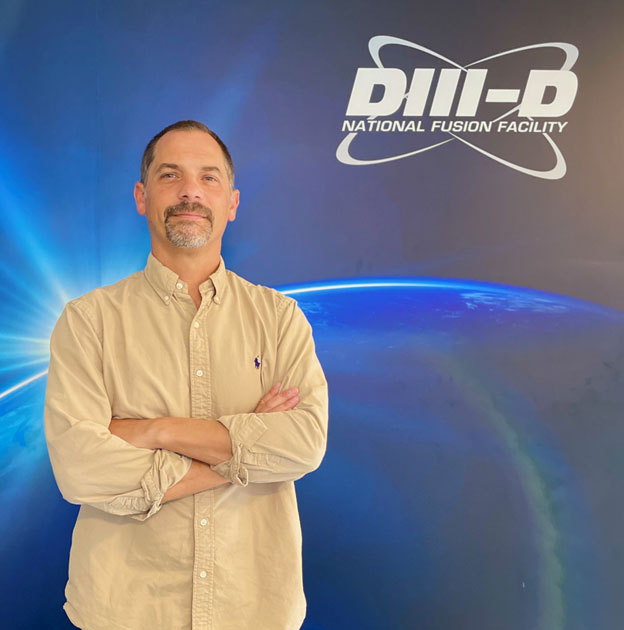General Atomics Researcher Named Fellow of the American Physical Society
Dr. Michael Van Zeeland recognized for advancing energetic-particle-driven instabilities and innovations in plasma diagnostics

San Diego – 05 Jan 2023 – General Atomics (GA) researcher Dr. Michael Van Zeeland has been selected as a 2022 Fellow of the American Physical Society (APS). Dr. Van Zeeland is a Staff Scientist at GA and was nominated for Fellowship by the APS Division of Plasma Physics.
The citation reads: “For experiments to understand and control Alfven eigenmode [AE] and other energetic-particle [EP]-driven instabilities in tokamak plasmas, and for diagnostic innovation and leadership.”
Fusion is the process that powers the stars, and it occurs when two light nuclei combine to form a new one, releasing vast amounts of energy. Researchers can create fusion using a tokamak, a device that uses heat, magnets, and microwaves to create a plasma – a highly ionized “soup” of charged particles that can be controlled by magnetic fields – with the goal of harnessing the energy produced in the reaction to create electricity.
AEs and other EP-driven instabilities are waves within a fusion plasma that are driven by, and interact with, certain types of charged particles known as “fast ions”. Fast ions can be generated in fusion reactions or through processes used to heat the plasma. Large EP-driven instabilities can cause fast ions to escape the plasma, leading to reduced power output or even damage to the interior wall of the fusion machine. Containing and controlling these types of instabilities is a key challenge for achieving practical fusion energy.
Dr. Van Zeeland’s research has contributed substantially to the understanding of AEs and other EP-driven instabilities, and it has yielded some of the most detailed measurements ever achieved for both AE structures and their impacts on fusion performance.
“Much of the progress we've been able to make in understanding AEs and EP-driven instabilities has been enabled by advances in diagnostics of the waves themselves, as well as the energetic particle population interacting with them,” said Dr. Van Zeeland. “Our goal is to generate a predictive capability for the impact of AEs and EP-driven instabilities in future fusion devices, as well as tools to control them.”
Dr. Van Zeeland conducted his experimental research with collaborators at the DIII-D National Fusion Facility in San Diego, California, and the Axially Symmetric Divertor Experiment (ASDEX) Upgrade in Garching, Germany. At DIII-D, Dr. Van Zeeland utilized the facility’s flexibility and leading diagnostics set to make measurements of AEs under various conditions and compare the results to state-of-the-art modeling tools. Working as part of a team of researchers, Dr. Van Zeeland helped pioneer a range of diagnostics that were applied to these and other experiments, including innovative techniques to measure small density fluctuations made by the waves, and generating the first imaging measurements of a fast particle profile. Dr. Van Zeeland also worked with an early career researcher to design a new diagnostic tool known as an “imaging neutral particle analyzer,” which provides unprecedented details of the movement of fast ions in the presence of AEs on DIII-D and other tokamaks worldwide.
In addition to his work at the DIII-D National Fusion Facility, Dr. Van Zeeland is part of a team of engineers and scientists developing the Toroidal Interferometer and Polarimeter (TIP) diagnostic for the international ITER experiment. Currently under construction in France, ITER is an unprecedented scientific collaboration of 35 nations that will prove the feasibility of fusion. The TIP will eventually be used as the primary tool for controlling the density of the ITER plasma.
“It’s my hope that TIP will allow us to see AEs and other waves in the core of ITER plasmas just like similar diagnostics have on DIII-D,” added Dr. Van Zeeland.
As described by APS, the Fellowship Program was created to recognize members who have made advances in physics through original research and publication or made significant innovative contributions in the application of physics to science and technology. Selection as a Fellow is a distinct honor, and no more than one half of one percent of the Society’s membership are named Fellows annually.
“General Atomics is incredibly fortunate to benefit from some of the very best minds in fusion, and Mike Van Zeeland is a perfect example of how one individual can make a real contribution to this field,” said Dr. Wayne Solomon, Vice President of Magnetic Fusion Energy. “Being named an APS Fellow is a testament to Mike’s hard work and leadership, and the contributions he has made to advancing fusion.”
“Being recognized as a fellow of the APS is truly an honor. I am very fortunate to work with such an outstanding team at GA and the DIII-D National Fusion Facility, and I've never been so optimistic about the potential for fusion energy and the benefits it offers to the world,” said Dr. Van Zeeland.
About General Atomics: Since the dawn of the atomic age, General Atomics innovations have advanced the state of the art across the full spectrum of science and technology – from nuclear energy and defense to medicine and high-performance computing. Behind a talented global team of scientists, engineers, and professionals, GA’s unique experience and capabilities continue to deliver safe, sustainable, economical, and innovative solutions to meet growing global demands.
About the DIII-D National Fusion Facility. DIII-D is the largest magnetic fusion research facility in the U.S. and has been the site of numerous pioneering contributions to the development of fusion energy science. DIII-D continues the drive toward practical fusion energy with critical research conducted in collaboration with more than 800 participants and over 400 actively contributing scientists representing over 100 institutions worldwide. As a U.S. Department of Energy, Office of Science User Facility, participation in DIII-D research is open to all interested parties. For more information, visit www.ga.com/diii-d.
For more information contact:
Evan Polisar
Strategic Communications Manager